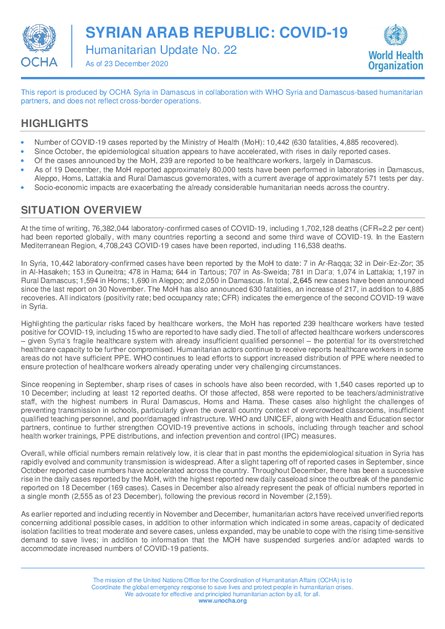
SITUATION OVERVIEW
At the time of writing, 76,382,044 laboratory-confirmed cases of COVID-19, including 1,702,128 deaths (CFR=2.2 per cent) had been reported globally, with many countries reporting a second and some third wave of COVID-19. In the Eastern Mediterranean Region, 4,708,243 COVID-19 cases have been reported, including 116,538 deaths.
In Syria, 10,442 laboratory-confirmed cases have been reported by the MoH to date: 7 in Ar-Raqqa; 32 in Deir-Ez-Zor; 35 in Al-Hasakeh; 153 in Quneitra; 478 in Hama; 644 in Tartous; 707 in As-Sweida; 781 in Dar’a; 1,074 in Lattakia; 1,197 in Rural Damascus; 1,594 in Homs; 1,690 in Aleppo; and 2,050 in Damascus. In total, 2,645 new cases have been announced since the last report on 30 November. The MoH has also announced 630 fatalities, an increase of 217, in addition to 4,885 recoveries. All indicators (positivity rate; bed occupancy rate; CFR) indicates the emergence of the second COVID-19 wave in Syria.
Highlighting the particular risks faced by healthcare workers, the MoH has reported 239 healthcare workers have tested positive for COVID-19, including 15 who are reported to have sadly died. The toll of affected healthcare workers underscores – given Syria’s fragile healthcare system with already insufficient qualified personnel – the potential for its overstretched healthcare capacity to be further compromised. Humanitarian actors continue to receive reports healthcare workers in some areas do not have sufficient PPE. WHO continues to lead efforts to support increased distribution of PPE where needed to ensure protection of healthcare workers already operating under very challenging circumstances.
Since reopening in September, sharp rises of cases in schools have also been recorded, with 1,540 cases reported up to 10 December; including at least 12 reported deaths. Of those affected, 858 were reported to be teachers/administrative staff, with the highest numbers in Rural Damascus, Homs and Hama. These cases also highlight the challenges of preventing transmission in schools, particularly given the overall country context of overcrowded classrooms, insufficient qualified teaching personnel, and poor/damaged infrastructure. WHO and UNICEF, along with Health and Education sector partners, continue to further strengthen COVID-19 preventive actions in schools, including through teacher and school health worker trainings, PPE distributions, and infection prevention and control (IPC) measures.
Overall, while official numbers remain relatively low, it is clear that in past months the epidemiological situation in Syria has rapidly evolved and community transmission is widespread. After a slight tapering off of reported cases in September, since October reported case numbers have accelerated across the country. Throughout December, there has been a successive rise in the daily cases reported by the MoH, with the highest reported new daily caseload since the outbreak of the pandemic reported on 18 December (169 cases). Cases in December also already represent the peak of official numbers reported in a single month (2,555 as of 23 December), following the previous record in November (2,159).